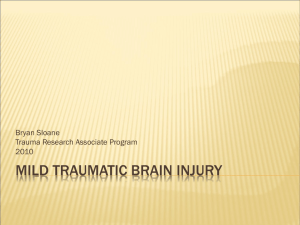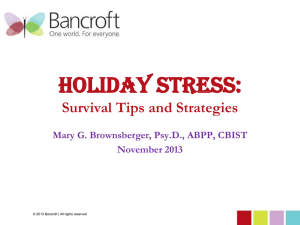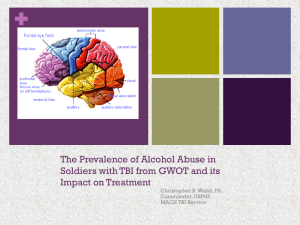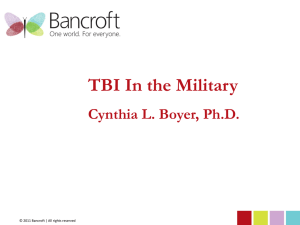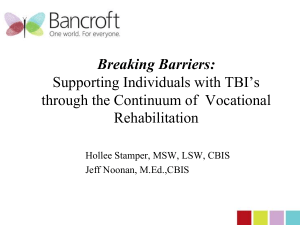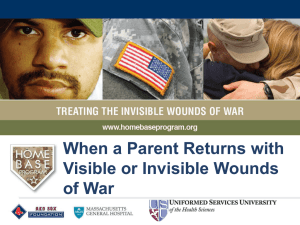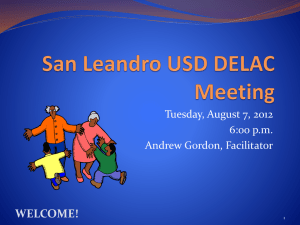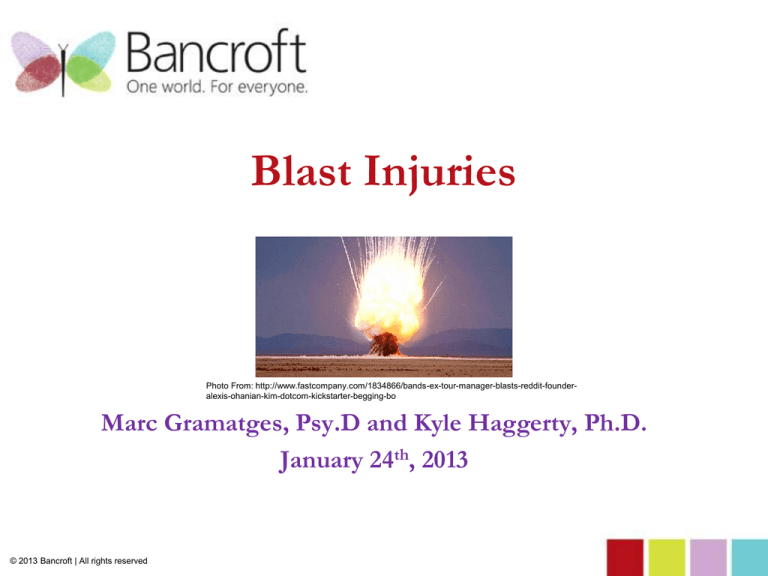
Blast Injuries
Photo From: http://www.fastcompany.com/1834866/bands-ex-tour-manager-blasts-reddit-founderalexis-ohanian-kim-dotcom-kickstarter-begging-bo
Marc Gramatges, Psy.D and Kyle Haggerty, Ph.D.
January 24th, 2013
© 2013 Bancroft | All rights reserved
Learning Objects
•
•
•
•
•
•
•
•
•
Statistics
Mechanisms of Injury
Signs and Symptoms
TBI and PTSD
Evaluation and Detection
Multiple TBIs
Treatment
Recovery
Living with a TBI
© 2013 Bancroft | All rights reserved
Statistics
© 2013 Bancroft | All rights reserved
Prevalence
• Over 7,000 American Soldiers have been killed in action during the Operation
Iraqi Freedom & Operation Enduring Freedom conflicts
• According to the Huffington Post, as of October 2012, over 50,000 soldiers
had been wounded
• The majority of those injuries were the result of Improvised Explosive
Devices (IED), and therefore blast injuries
• These injuries include amputations, fractures, and many include
concussions which are mild Traumatic Brain Injuries (mTBI)
© 2013 Bancroft | All rights reserved
Prevalence
• Two-thirds of war zone evacuations and 88% of
injuries treated were due to blast injury
• 50% of all wounds sustained by combatants in
action were blast injuries
• Blast injuries in the civilian population are also on
the rise
© 2013 Bancroft | All rights reserved
Photo:
http://news.bbc.co.uk/2/hi/in_pictures/61
77540.stm
Positive Side
• More and more soldiers are surviving exposure to blast injuries
• Due largely to improvements in body armor, which prevent
penetrating injuries, and also damped the effects of the blast
wave on the heart and lungs
Photo: 10TH COMBAT SUPPORT HOSPITAL, Baghdad-Soldiers from Troop A, 1st Squadron, 10th Calvary
Regiment, 2nd Brigade Combat Team, 4th Infantry Division,
surround Staff Sgt. Michell Caldwell, scout, Troop A, 1-10
Cav, following his re-enlistment. Moments after he took the
oath, he was evacuated to Germany to treat gunshot
wounds to both forearms sustained on a combat patrol with
the men earlier the same day. (U.S. Army photo courtesy of
1-10 Cav.)
• However, more survivors means it is becoming more important to
understand the effects of being exposed to a blast, both short and
long term.
© 2013 Bancroft | All rights reserved
Mechanisms of Injury
© 2013 Bancroft | All rights reserved
Types of Blasts
• High order explosive
• Explosion is supersonic
• Blast contains a over-pressurized wave
• A wave where the air is compressed to a
point where it can itself be dangerous
• Followed by under-pressure as the air
pressure drops before returning to
normal
• Low order explosive
• Explosion is not as fast as the speed of sound
• No over-pressurization wave
© 2013 Bancroft | All rights reserved
Photo: MIT Technology Review
Blasts
• Primary: Over-pressurization shock wave followed by an underpressurization wave. Frequently causes TBI, lung injury, and tympanic
membrane ruptures.
• Secondary: Bomb fragments and shrapnel, propelled by the explosion,
impact the victim. Frequently causes lacerations, amputations, and open
head injuries.
• Tertiary: The blast wind throws the body of the victim against another
object. Common cause of mTBIs.
• Quaternary: Injury from exposure to the heat, chemicals, or radiation in the
explosion .
© 2013 Bancroft | All rights reserved
© 2013 Bancroft | All rights reserved
Nature of Injuries
• Research used to focus primarily on damage to gas filled organs (e.g.
lungs or intestines), as these were believed to be the organs most
significantly affected by blast exposure
• The brain was previously believed to be largely protected by
blasts due to the skull
• It has now been determined that the brain is just as susceptible
to blast injury as other organs
• In fact, TBI has been identified as one of the more frequent injuries
during the current conflicts, and accounts for a greater proportion
of injuries than in any previous conflict
© 2013 Bancroft | All rights reserved
What Happens to the Brain
• Studies on rats have revealed that even when the head is protected,
blast injuries causes significant neural damage
• Damage was particularly severe in the hippocampus of rats
• It was hypothesized that the hippocampus was more
susceptible to injury due to its sensitivity to oxygen
deprivation
• Rats showed signs of cognitive impairments and stress reactions
following the injuries
© 2013 Bancroft | All rights reserved
What Happens to the Brain
• The blast wave or any penetrating injury may interfere with blood
flow in the brain, depriving the brain of needed oxygen.
• Compression of the tissue can worsen the effect, by reducing brain
tissue oxygen levels
© 2013 Bancroft | All rights reserved
Signs and Symptoms
© 2013 Bancroft | All rights reserved
Mild TBI Symptoms
•
There are no symptoms that are unique to mTBI
•
Many post-concussion symptoms can be seen within healthy individuals
•
mTBI symptoms can overlap with other conditions
• Post Traumatic Stress Disorder (PTSD), depression, or other health
conditions
© 2013 Bancroft | All rights reserved
What are Common Signs and
Symptoms of TBI?
• Physical
• Headache
• Sleep disturbance
• Dizziness
• Balance problems
• Nausea/vomiting
• Fatigue
• Visual disturbances
• Sensitivity to light
• Ringing in the ears
© 2013 Bancroft | All rights reserved
• Cognitive
• Concentration
problems
• Temporary gaps in
memory
immediately after
injury
• Attention
problems
• Slowed thinking
• Difficulty finding
words
• Emotional
• Irritability
• Anxiety
• Depression
• Mood swings
Can be Difficult to Detect
•
Most soldiers remain on active duty following exposure to a blast
•
Some of the symptoms can worsen following the injury
•
The symptoms of mTBIs can be particularly difficult to detect
Photo: Joe Radle/Getty Images
© 2013 Bancroft | All rights reserved
Warning Signs
•
•
•
•
•
•
•
•
•
Worsening headaches
Worsening balance
Double vision or other vision changes
Decreased level of alertness
Increased disorientation
Repeated vomiting
Seizures
Unusual behavior
Amnesia/memory problems
© 2013 Bancroft | All rights reserved
Time of
Injury
Mild TBI
Moderate
TBI
Severe
TBI
© 2013 Bancroft | All rights reserved
TBI and PTSD
© 2013 Bancroft | All rights reserved
Correlation Between PTSD
and TBI
•
Research suggests that PTSD is more likely following TBI
• Incidence 13%-27%
• Prevalence 3%-59%
(Bryant, 2000)
•
Some researchers argued that PTSD following a head injury was not possible
due to memory loss, but many of those hypotheses have not been supported
by the data
© 2013 Bancroft | All rights reserved
Risk Factors for Developing
PTSD Following a TBI
•
•
•
•
•
Female
Avoidant
Lesions to the left temporal lobe
Pre-morbid depression or anxiety
Early symptoms of depression following the injury
© 2013 Bancroft | All rights reserved
Diagnosis Criteria for PTSD
Photo: This Sept. 29, 2009 photo shows
U.S. Marine Lance Cpl. Greg Rivers, 20, of
Sylvester, Ga., waiting to take psychological
tests at the Marine Corps Air Ground
Combat Center in Twentynine Palms, Calif.
(Jae C. Hong/ASSOCIATED PRESS)
• Criteria A
• The person experienced, witnessed, or was confronted with an event
involving actual or threatened death, serious injury or a threat to physical
integrity of self or others
• The person’s response involved intense fear, helplessness or horror
© 2013 Bancroft | All rights reserved
Continued
• Criteria B
• The traumatic event is re-experienced in one or more of the following
ways
• Recurrent images, thoughts or perceptions
• Recurrent distressing dreams of the event
• Acting or feeling as if the event was recurring
• Intense psychological distress OR physiologic reactivity at exposure
to cues that symbolize or resemble an aspect of the event
© 2013 Bancroft | All rights reserved
Continued
• Criteria C
• Persistent avoidance of stimuli associated with trauma and numbing as
indicated by 3 or more:
• Avoiding thoughts, feelings, or discussion, activities, places or people
that bring back recollections; sense of foreshortened future
• Inability to recall; restricted affect
• Diminished interest or participation
• Feeling detached or estranged
© 2013 Bancroft | All rights reserved
Continued Some More
• Criteria D
• Persistent symptoms of increased arousal by 2 or more:
• Difficulty falling or staying asleep
• Irritability or outbursts of anger
• Difficulty concentrating
• Hypervigilance
• Exaggerated startle response
• Criteria E
• Duration for more than 1 month
© 2013 Bancroft | All rights reserved
Where Is the Difference?
•
All of the Criteria except for one are frequently met by someone who suffered
a significant head injury.
• The exception is criteria B (Re-experiencing the trauma)
© 2013 Bancroft | All rights reserved
Symptoms of TBI and PTSD
PTSD Symptoms
Mild TBI Symptoms
Memory Problems
Memory Problems
Poor Concentration
Poor Concentration
Depression
Depression
Irritability
Irritability
Sleep Difficulties
Sleep Difficulties
Avoidance
Headaches
Re-experiencing Symptoms
Dizziness
© 2013 Bancroft | All rights reserved
PTSD
Cognitive
Impairment
TBI
© 2013 Bancroft | All rights reserved
Detection and Evaluation
© 2013 Bancroft | All rights reserved
Evaluation
•
The overarching goal of assessment is to identify those patients who have
suffered a mTBI, treat their symptoms and identify any co-occurring
conditions that may delay their return to duty.
•
Imaging studies are not necessary for the majority of mTBI patients. Imaging
is typically negative in this population but should be preformed whenever
more severe pathology is suspected.
© 2013 Bancroft | All rights reserved
Copyright:© 2012 Nucleus Medical
Art/Doctor Stock
© 2013 Bancroft | All rights reserved
Detection
•
Diffusion Tensor Imaging (DTI)
• MRI-based neuroimaging technique that allows visualization of the
brain's white matter tracts.
•
Susceptibility Weighted Imaging (SWI)
• Fully flow compensated, long echo, gradient echo (GRE) scan to acquire
images
© 2013 Bancroft | All rights reserved
Blunt Trauma
•
Service members almost always also suffer blunt trauma after blasts
Photo: http://www.medpagetoday.com/CriticalCare/HeadTrauma/31744
© 2013 Bancroft | All rights reserved
Blast vs Blunt?
•
DTS and SWI shows evidence of nerve damage in 30-40 percent of service
members who are symptomatic from a mTBI.
•
There is no clear evidence that the types of combat-related mTBI are
significantly different for blast or blunt trauma from sports.
•
Recent neuropsychological studies have found no measurable differences in
cognitive performance between blast and blunt injuries.
© 2013 Bancroft | All rights reserved
Screening
•
Individuals who sustain a mTBI often do not seek out medical attention
•
In 2011 the Department of Defense instituted a requirement that all service
members exposed to a blast event (within 50 meters), or who were inside a
vehicle or building exposed to a blast, must be removed from combat for at
least 24 hours and be medically evaluated prior to return to duty
© 2013 Bancroft | All rights reserved
Evaluation
•
In the military, corpsmen and medics are expected to use the Military Acute
Concussion Evaluation (MACE) which consists of standardized testing of
cognition, neurologic functions including balance, and a symptom screen.
•
Those individuals who remain symptomatic 24-48 hours after the injury are
often referred for further testing.
© 2013 Bancroft | All rights reserved
Multiple TBIs
© 2013 Bancroft | All rights reserved
Cumulative mTBI
•
Prior history of mTBI may be associated with slower recovery.
•
Thus, there is a substantial body of evidence that suggests worsened brain
injury, and worsened neurologic outcomes, associated with multiple mTBI.
© 2013 Bancroft | All rights reserved
Long Term Effects of mTBI
•
Increased sensitivity to future head injuries
• Athletes with a history of 3 or more mTBI are more likely to lose
consciousness, experienced amnesia and confusion, and emergency
symptoms following another mTBI.
•
Studies have shown neurological changes in individuals who have sustained
multiple mTBI.
• However, the exact nature of the deficits seen in individuals who suffer
multiple head injuries has not yet been clearly identified.
•Collins, M. W., Lovell, M. R., Iverson, G. L., Cantu, R. C., Maroon, J. C., Field, M (2002).
Cumulative Effects of Concussion in High School Athletes. Neurosurgery, 51, 1175-1181.
© 2013 Bancroft | All rights reserved
Cumulative mTBI
•
Chronic traumatic encephalopathy (CTE), a form of dementia, may result
from multiple mTBI, either those sustained in the military from multiple blast
injuries, or from contact sports such as boxing and football.
•
CTE appears as a progressive decline of memory and cognition, as well as
depression, suicidal behavior, poor impulse control, aggressiveness and,
eventually, dementia. In addition, long term and possibly permanent damage
to the pathways, or wiring, of the brain can be caused by mTBI.
© 2013 Bancroft | All rights reserved
Treatment
© 2013 Bancroft | All rights reserved
Medical Evacuation
•
•
Initial life saving treatment begins on the battlefield but often leads to medical
evacuation.
– Combat support hospitals
– Landstuhl Regional Medical Center (LRMC) in Germany
• Trauma surgery
• Neurosurgery
• Neurology
• Critical care doctors and nurses
– Designated inpatient TBI centers in continental United States (CONUS)
• Walter Reed National Military Medical Center in Bethesda, Md.
• Brooke Army Medical Center in San Antonio, Texas.
This cycle of evacuation can occur in as few as 72 hours — much more
quickly than in previous conflicts which sometimes took 30 days or more.
© 2013 Bancroft | All rights reserved
The Individual
•
Treatment for post-concussional syndrome
should be developed around the specific
symptom constellation presented by an individual
patient.
•
Psycho-education has been shown to significantly
decrease distress in response to post-concussional
symptoms.
Photo: http://www.army.mil/article/11222/neurologist-brings-important-skills-to-iraq/
© 2013 Bancroft | All rights reserved
Interdisciplinary Therapy
•
Interdisciplinary teams are common and sometimes necessary for the
management of TBI:
– Audiology/vestibular
– Cognitive rehabilitation
– Neuropsychology
– Occupational therapy
– Optometry
– Pharmacy
– Physical therapy
– Primary care
– Speech and language pathology
– Other specialties
© 2013 Bancroft | All rights reserved
Continued
•Psychotherapy and psychopharmacology have been found to be effective in treating
many of the psychological symptoms of mTBI.
•Pharmacologic therapy of mTBI is often necessary for the treatment of symptoms
such as headache, nausea and insomnia. It is also critical to identify co-occurring
conditions such as depression, anxiety and PTSD. A key point to consider when
prescribing medications are low dose with slow titration.
•However some psychotropic medications have been shown to slow cognitive
recovery.
© 2013 Bancroft | All rights reserved
Continued
•
Rest is often the best way for the brain to recover
from a mTBI.
• This means avoiding general physical exertion as
well as mental exertion (including school and
leisure activities like watching TV).
• AVOID A SECOND TBI
• As previously described, it can be very dangerous
to suffer a second mTBI before the symptoms of
the first have subsided.
© 2013 Bancroft | All rights reserved
Recovery
© 2013 Bancroft | All rights reserved
Prognosis
•
The vast majority of those with mTBI have a complete recovery, usually
within minutes or hours.
•
Risk factors for prolonged symptoms include loss of consciousness associated
with the impact, history of previous mTBI, or a history of certain behavioral
problems such as anxiety.
© 2013 Bancroft | All rights reserved
Prognosis
•
For the small proportion who remain symptomatic, the most common mTBI
symptoms are headaches, sleep disturbances and balance problems or
dizziness.
•
Approximately 50 percent of those with post-traumatic stress disorder have
had a mTBI, and approximately 50 percent of those with a mTBI who remain
symptomatic for weeks or months will develop post-traumatic stress disorder.
•
Multiple mTBIs may lead to prolonged or permanent cognitive and other
neurologic problems.
© 2013 Bancroft | All rights reserved
Why Does mTBI Affect
Returning to Duty?
•
Symptoms after a mTBI can affect performance and place the service member
or their unit in danger.
•
These temporary symptoms resolve faster when the brain gets rest, so it is
important to take time to recover.
•
If the service member sustains another mTBI before healing from the first
one, his or her recovery might take longer.
© 2013 Bancroft | All rights reserved
Duty Restrictions
•
Duty restrictions should be based on the individual needs of the patient and
their provider’s judgment.
•
In the acute phase (first seven days), symptomatic patients should be
considered for limited duty hours to facilitate brain recovery.
•
Slowly increasing the patient’s physical activity should be encouraged and
monitored.
•
Exertion testing should be performed when a patient with a mTBI has
recovered to a point where return to duty is considered. This helps ensure that
symptoms do not recur with physical stress. (At the present time there is no
clinical practice guideline for return to duty decisions).
© 2013 Bancroft | All rights reserved
Returning to Duty
•
Rest should include physical as well as mental work.
• It also is important to avoid activities that would put the brain at risk for
a second injury before the brain has been given adequate time to heal.
•
A medical provider will determine when a service member should return to
duty.
• Going back to work too soon may cause symptoms to recur or worsen.
© 2013 Bancroft | All rights reserved
What Can Service Members
Do To Return To Duty
Faster?
•
•
•
•
•
•
•
•
•
•
•
•
Maximize downtime and rest.
Sleep is key to recovery. Get six to eight hours of sleep.
Protect themselves from another mTBI by avoiding contact sports, combatives, etc.
Let others know that they have had a mTBI so they can watch out for them.
Drink plenty of water.
Follow their medical provider’s instructions and be honest about their symptoms.
Avoid alcohol and drug use. (Alcohol and drug use significantly slow down recovery).
Avoid caffeine, energy drinks and other “energy-enhancing” products that might interfere with
sleep.
Don’t take any medications, including over-the-counter medications, unless their medical provider
instructs them to.
Avoid sleeping aids and sedatives unless their provider advises them to take them.
Don’t do physical work, heavy lifting or exercise until cleared by their medical provider.
Limit activities that require intense concentration, such as writing reports or playing video games.
© 2013 Bancroft | All rights reserved
Living with a TBI
© 2013 Bancroft | All rights reserved
What are Some Coping Tips for
Service Members?
•
•
•
•
•
•
•
Write things down; carry a small pad and pen.
Store important items, such as your keys or your wallet, in the same
designated place to keep from losing them.
Keep a steady pace. Take breaks as needed.
Focus on one thing at a time.
Perform tasks in a quiet, non-distracting environment.
If feeling irritable or angry, try relaxation techniques and/or walking away
from the situation.
Think about the obvious:
• Are you irritable or having trouble concentrating? Are you getting enough
sleep?
• Are you having trouble sleeping? Are you drinking energy drinks or
alcohol?
© 2013 Bancroft | All rights reserved
Prevent Additional TBIs
•
Buckle seat belts
•
Avoid clutter around the home
•
Use caution on slippery surfaces
•
Wear appropriate shoes
•
Use appropriate aid devices (walkers,
wheelchairs, etc.)
© 2013 Bancroft | All rights reserved
Resources
•
Brain Injury Association of America
•
Centers for Disease Control and Prevention
•
The Defense and Veterans Brain Injury Center
•
U.S. Department of Veterans Affairs
© 2013 Bancroft | All rights reserved
References
Brain Injury Association of America (2013). Retrieved December 28, 2012, from http://www.biausa.org/
Bryant, R. A., Marosszeky, J.E., Crooks, J., & Gurka, J. A. (2000). Posttraumatic stress disorder after severe traumatic brain injury. American Jounral
of Psychiatry, 157, 629-631.
Centers for Disease Control and Prevention (2013). Retrieved December 28, 2012, from www.cdc.gov
Defense and Veterans Brain Injury Center (2013). Retrieved December 28, 2012, from http://www.dvbic.org/
DeWitt, D., & Prough, D. (2009). Blast-induced brain injury and posttraumatic hypotension and hypoxemia. Journal of Neurotrauma, 26, 877-887.
Koliatsos, V., Cernak, C., Xu, L., Song, Y., Savonenko, A., Crain, B., Eberhart, C., Frangakis, C., Melnikova, T., Kim, H., & Lee, D. (2011). A
mouse model of blast injury to brain: initial pathological, neuropathologicalm and behavioral characterization. Journal of
Neuropathology, 70, 399-416.
Sullivan, E. (2012). War-related PTSD, blast injury, and anosognosia. Neuropsychological Review, 22, 1-2.
U.S. Department of Veterans Affairs (2013). Retrieved December 28, 2012, from va.gov
Wilk, J. E., Thomas, J. L., McGurk, D. M., Riviere, L. A., Castro, C. A., & Hoge, C. W., (2010). Mild traumatic brain injury (concussion) during
combat: lack of association of blast mechanisms with persistent postconcussive symptoms. Journal of Head Trauma Rehabilitation,
25, 9-14.
© 2013 Bancroft | All rights reserved
Contacts
Email:
marc.gramatges@bancroft.org
kyle.haggerty@bancroft.org
Twitter: Kyle Haggerty @DrKyleHaggerty
© 2013 Bancroft | All rights reserved

